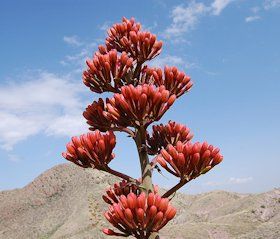
|
Some Common Myths Thought to be True - Myth 144
Myth 144: The Century Plant Blooms Every 100 Years
Agave americana, common names century plant, maguey or American aloe, is a
species of flowering plant in the family Agavaceae, originally native to
Mexico, Arizona and Texas but cultivated worldwide as an ornamental plant. It
has become naturalized in many regions including the West Indies, parts of
South America, the Mediterranean Basin, parts of Africa, India, China, Korea,
Thailand, New Zealand, Australia and an assortment of oceanic islands. Despite
the common name "American aloe," it is not closely related to plants in the
genus Aloe.
|
| Century Plant Bloom | |
|
The century plant's leaves spread out from a central core, resembling a rosette. The plant, which actually takes an average of 15 years to flower, does not look like much until it comes time for it to bloom. A large stalk, 15 to 40 feet (4.572 to 12.192 meters) high and as thick as a tree trunk, shoots up from the middle of the plant and produces hundreds of clustered white or yellow flowers. The blooms remain on the century plant for about a month before the stalk begins to wither and die, killing off the rest of the plant with it. |
|
| ⇦ Back to Myth 143 Return to Myth Choices Page 11 On to Myth 145 ⇨ | |